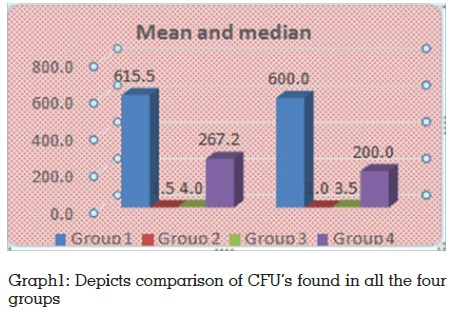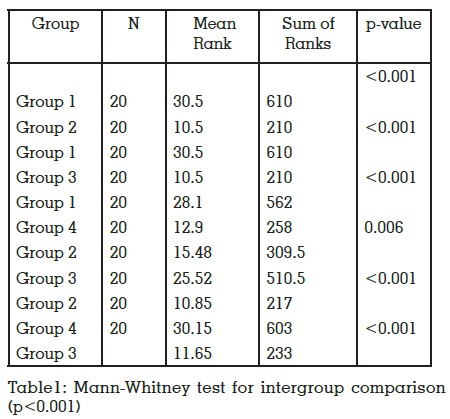

Background: The purpose of this study was to evaluate and compare the antifungal effects of commercially available denture cleansers with ozone water on heat cure resin samples.
Methods : 80 heat cure resin samples were fabricated and cultured with C.albicans. After cleaning with 2 different cleansers and ozone water, number of CFUs were counted.
Results: Denture cleansers principally containing sodium lauryl sulphate sodium hypochlorite showed highest Candida lytic activity, when compared with the ozone water and control group. Among the denture cleansers used, Clinsodent containing sodium lauryl sulphate was found to be more effective than Fittydent denture cleanser. Ozone water generated from domestic ozone generator showed significant antifungal effects but less than that of denture cleansers.
Conclusion: Despite of having proved efficiency of ozone as antibacterial, antifungal and antiviral, ozone water alone could not completely remove the attached C.albicans from the surface of heat cure resin blocks.
Denture stomatitis is one of the most widespread and long standing problem in denture wearing patients. Condition is suggestive of inflammation of oral mucosa which is in direct contact with denture base especially the palatal and gingival mucosa. The etiopathogenesis of denture stomatitis is multifactorial and complex to understand.1 Among the various species of Candida, Candida albicans is proven to be the main Candida strain responsible for denture stomatitis.2 Principal location of Candida albicans in oral cavity is posterior tongue and sites such as the mucosa along with dental surfaces which are covered by film and are colonized secondarily.3 Denture surface itself can produce a number of favourable changes for the accumulation of bacteria and yeast. The intaglio surface of the dentures usually show micropits and microporosities, which makes possible for the yeast to nest. Also, in patients with improper oral hygiene, Candida can stick, penetrate and accumulate with bacterial communities.4
Candida-associated denture stomatitis is difficult to treat, because of its multifactorial etiology5 and is largely dependent upon a exhaustive plan. Removal of etiological factors is considered the first and foremost crucial step. To prevent and remove the aggregation of microorganisms and to remove mucine, food remains, calculus and stains, a routine of denture cleaning must be performed. Denture cleaning is achieved mechanically by brushing, chemically by use of chemical agents or by the association of both methods.6 It has been shown that dentures cannot be cleaned effectively by the mechanical methods.6 Chemical methods are considered more effective and indispensable for daily denture care, which includes hypochlorites, peroxides, various acids and enzymes. But, some chemical agents have been reported to damage acrylic resin by altering the surface properties of acrylic resin7,8 compared to the ozone water which was used in our study. Null hypothesis for the current study was that, there were no antifungal effects associated with commercial denture cleansers and with the ozonated water on heat cure resin.
In the present study, a total of 80 heat cure resin samples were taken as per statistician’s recommendation based on mean values and standard deviation in the available previous literature, and were divided into four equal groups. Group 1 was immersed in distilled water (control group). Group 2 & 3 were immersed in two different denture cleansers. Group 4 was immersed in ozone water (Test Group). In our study it is suggested that denture cleaning can be done by using appropriate dose of ozone water as ozonated water has been shown to be a powerful antimicrobial agent against bacteria, fungi, protozoa, and viruses,9 and it is also generally accepted that ozone destroys cell wall and cytoplasmic membranes of several microorganism by its oxidation action.10
The whole study protocol was divided into four parts
The experimental 80 heat cure resin plates using DPI Heat Cure material were prepared from a specially designed metal mould having a window of dimension 15×15mm and thickness 1.5mm to simulate the denture thickness.11 The prepared heat cure resin plates were then grounded with medium grit abrasive paper polished with pumice, and immersed in water for 24 hours to remove all remaining monomer and were later dried and disinfected by immersing in 40% formaldehyde for half an hour. Then, the resin plates were ready for the next procedure.
C. albicans (ATTC10321) strain was used for the preparation of fungal suspension in Sabouraud’s Dextrose Broth. It was incubated at 37°C overnight and was centrifuged. Sterile saline was used for washing of fungal cells three times and suspended again in sterile saline. Cell suspension was diluted to 3×107 per cell with serial dilution.12 Firstly, resin plates were coated with human serum. After that 500μl protein solution (GDR) was dispensed on to each resin plate. Plates were kept in incubator at 37°C for 1 hour. After 1 hour, protein solution was aspirated. Then 50μl of fungal suspension was dispensed and was incubated at 37°C for 2 hours to promote yeast adherence and colonization. Lastly, 2ml of sabouraud’s dextrose broth (Hi Media) was dispensed in each petri plate and plates were incubated for 1-6 days.
After the colonization assay, all resin plates were washed three times with sterile saline to remove all loosely attached microoraginsms. Then, all resin plates were subjected to cleaning procedures.
Group 1(G1) was immersed in distilled water for one hour.
Group 2(G2) was immersed in Clinsodent denture cleanser (I.C.P.A Health Products Ltd) for one hour.
Group 3(G3) was immersed in Fittydent denture cleanser (Group Pharmaceuticals) for one hour.
Group 4(G4) was immersed in ozone water (Prestige Domestic Ozone Generator) for one hour.
After the cleaning procedures, the plates from each experiment were placed in a small beaker containing sterile saline to immerse the resins completely, and then were agitated in a magnetic stirrer & rotator to release the loosely attached Candida albicans. Sabauraud’s dextrose agar(Hi-Media) was prepared by measuring in adequate amount and then it was autoclaved. After sterilization of the SDA, 15ml of SDA was poured in each of the sterile petri plates. SDA plates were allowed to solidify at room temperature. All plates were kept in incubator at 37°C for drying. Now, SDA plates were ready for the culture. Swabs were taken from the resin sample with sterile cotton swab after cleaning procedure. After taking swab from sample, it was cultured on SDA plates by swab method at 37°C for 24 hours to one week.
After 24 hours of incubation, colony forming units(CFU) were formed on SDA plates. Colony forming units were counted from all the plates from each group by digital colony counter before and after the cleaning procedures.

Effects of two commercially available denture cleansers (Clinsodent & Fittydent) and ozonated water were evaluated and compared with control group. To allow comparison between the combinations of denture cleansers and ozone water, the difference in number of colonies was calculated as the percentage inhibition of fungal growth. Maximum number of CFUs were found in control group followed by ozone water and almost no growth or very few colonies were found in denture cleansers (Graph1) indicated the maximum antifugal activity of denture cleansers followed by ozone water. Mann Whitney test was also applied for intergroup comparison (Table 1). Results showed statistical significant differences when each group was compared with control group (p<0.001) and compared to each other. But, when group 2 and group 3 were compared to each other. No statistical significant difference (p= 0.006) was found (Table 1) indicated that there was not much difference in the antifungal activity between the two groups.
Potential applications of ozone in the clinical practice of dentistry and medicine is reported to be based on the actions such as antimicrobial, antiinflammatory, immuno-modulating, biosynthetic, bioenergetic, antihypoxic, analgesic and hemostatic effects.13 Considering the above mentioned advantages ozone water was selected as a antifungal agent against C.albicans on heat cure resin in our study, which was generated at a concentration of 200mg/hour.

Domestic ozone water generator was used in the present study because it is generally available at homes for disinfecting fruits and vegetables nowadays. Whereas, commercial ozone water generator is not easily available at homes and cost factor is also a concern for the patient. Time duration recommended for ozone water generator (Prestige) is 10, 20 and 30 minutes. It was decided to generate ozone for 30 minutes with the heat cure resin plates immersed in it to ensure the maximum antifungal activity. After that, samples were allowed to immerse in ozonated water for another 30 minutes as ozone does not disintegrate till 40 minutes. To reduce the confounding factors, all the samples were immersed for same time period of 1 hour in respective cleansers after the colonization assay. Among the two denture cleansers tested, very less statistical difference was found (p=0.006) between the two cleansers. Which states that there was not much difference in the antifungal activity between group 2 and group 3. However, Clinsodent demonstrated noticeable reduction in number of colony forming units when compared with Fittydent. This might be due to presence of sodium lauryl sulphate in Clinsodent denture cleanser. These results were in accordance with the study conducted by Mithilesh M et al.11 Delise Pellizzaro et al,14 Silva FCet al.15 in which they compared and evaluated Candida removing effects of three different denture cleansers on heat cure resin plates. Results were in contrast with the studies done by Ana Paula Coelho Vieira et al.16, Kumar MN et al.17 In their study, Fittydent was found to be more effective when compared with Clinsodent. As the methodology in their study was different, they had used immersion time period of 8 hours.
Heat cure acrylic resin blocks immersed in ozonated water showed marked antifungal activity when it was compared with control group. 50-150 CFUs were still observed on the heat cure resin blocks, suggested that complete antimicrobial activity did not occur on treating with ozone water alone. On the other hand, No CFU was observed when only the prepared fungal suspension (which was used for the growth of C.albicans on heat cure resin blocks) was treated with ozone water indicated that, ozone has a potent antimicrobial properties. But, when the same fungal suspension was cultured onto heat cure resin blocks, ozone water alone could not completely kill the C. albicans growth from the surface of heat cure resin. These results are in agreement with that of Nagayoshi M et al.21 who found very strong antifungal effects of ozone against C.albicans. and concluded that ozonated water has strong antifungal and antibacterial effect on oral microorganisms. But, they did not examine antifungal effects on heat cure resin. The difference in antifungal activity of ozonated on heat cure reason might be due to the surface properties of resin. Also, the antifungal activity of ozonated water is also dependent upon the number of CFU present on the heat cure resin or the microbial load.18 Arita M et al.19 and A.Dilek Nalbant et al.20 also did not found strong association of using ozonated water alone as a antifungal agent against C.albicans on heat cure resin plates. Results of our present study concluded that microbicidal activity against C.albicans did not show any significant results on resin plates between commercial denture cleansers and combined activity of ozonated water with ultrasonication. Whereas, treatment with ozone water alone had a weak effect on C.albicans. After obtaining of all the results, Null hypothesis was discarded. Nowadays, various other newer heat cure resin material with incorporation of antifungal agents have also been introduced in market. But, they have been reported to affect the tensile strength and colour of heat cure resin material.22,23
Within the limitations of the study it was concluded that despite of the strong antifungal effects of commercially available denture cleansers on heat cure resin, they are not well recommended to use for this purpose because of their possibility of bleaching effect on acrylic denture base. Further studies are required to evaluate the antifungal effects of ozone water at different concentrations and for different durations.